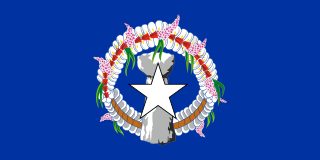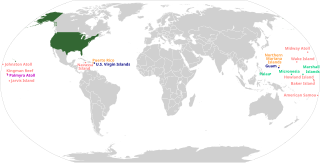The history of Guam starts with the early arrival around 2000 BC of Austronesian people ent American rule of the island began with the 1898 Spanish–American War. Guam's history of colonialism is the longest among the Pacific islands.

The Northern Mariana Islands, officially the Commonwealth of the Northern Mariana Islands, is an unincorporated territory and commonwealth of the United States consisting of 14 islands in the northwestern Pacific Ocean. The CNMI includes the 14 northernmost islands in the Mariana Archipelago; the southernmost island, Guam, is a separate U.S. territory. The Northern Mariana Islands were listed by the United Nations as a non-self governing territory until 1990.

The 51st state is a term in American political discourse that refers to areas considered to be candidates for U.S. statehood, joining the 50 United States existing since 1959. The phrase has been applied to external territories, as well as the country's capital for the District of Columbia and parts of already-existing states which would be admitted as separate states in their own right.
Commonwealth is a term used by two unincorporated territories of the United States in their full official names, which are the Northern Mariana Islands, whose full name is Commonwealth of the Northern Mariana Islands, and Puerto Rico, which is named Commonwealth of Puerto Rico in English and Estado Libre Asociado de Puerto Rico in Spanish, translating to "Free Associated State of Puerto Rico." The term was also used by the Philippines during most of its period under U.S. sovereignty, when it was officially called the Commonwealth of the Philippines.
In the United States, each state has its own written constitution.

Midterm elections in the United States are the general elections that are held near the midpoint of a president's four-year term of office, on Election Day on the Tuesday after the first Monday in November. Federal offices that are up for election during the midterms include all 435 seats in the United States House of Representatives, and 33 or 34 of the 100 seats in the United States Senate.
Benjamin Taisacan Manglona was a Northern Marianan politician and civil engineer. He is the CNMI's longest serving elected official having served as a congressman, senator, and former mayor of Rota. Manglona served as the third lieutenant governor of the Northern Mariana Islands from 1990 to 1994 and as Mayor of Rota from 1998 to 2006.

General elections were held in the Commonwealth of the Northern Mariana Islands (CNMI) on Saturday, 5 November 2005, electing the governor and Legislature. There was also a referendum on calling a Constitutional Convention, which was approved by voters. The gubernatorial election was the closest in the commonwealth's history, and resulted in the election of Benigno Fitial, narrowly defeating independent Heinz Hofschneider by 84 votes and incumbent Republican Governor Juan N. Babauta by an additional 98 votes.

The Northern Mariana Islands Commonwealth Legislature is the territorial legislature of the U.S. commonwealth of the Northern Mariana Islands. The legislative branch of the territory is bicameral, consisting of a 20-member lower House of Representatives, and an upper house Senate with nine senators. Representatives serve two-year terms and senators serve four-year terms, both without term limits. The territorial legislature meets in the commonwealth capital of Saipan.

The Northern Mariana Islands' first election of a delegate to the United States House of Representatives took place on November 4, 2008. Since the CNMI traditionally had general elections in odd-numbered years, the November 2008 ballot contained only this office.

The Refaluwasch people are a Micronesian ethnic group who originated in Oceania, in the Caroline Islands, with a total population of over 8,500 people in northern Mariana. They are also known as Remathau in the Yap's outer islands. The Carolinian word means "People of the Deep Sea." It is thought that their ancestors may have originally immigrated from Asia and Melanesia to Micronesia around 2,000 years ago. Their primary language is Carolinian, called Refaluwasch by native speakers, which has a total of about 5,700 speakers. The Refaluwasch have a matriarchal society in which respect is a very important factor in their daily lives, especially toward the matriarchs. Most Refaluwasch are of the Roman Catholic faith.

An unofficial referendum on integration with Guam was held in the Northern Mariana Islands on 27 October 1963. Although the proposal was approved by voters, the islands were not integrated.

A referendum on the status of the Northern Mariana Islands was held on 5 February 1961. Although 65% of voters supported integration with Guam, the United States did not integrate the islands.

A referendum on the status of the Northern Mariana Islands was held on 9 November 1969. For the fourth time since 1958 a majority of voters supported integration with Guam. However, a referendum held in Guam on 4 November on integration with the Northern Mariana Islands had been rejected by 58% of Guamanian voters.

A referendum on becoming a US commonwealth was held in the Northern Mariana Islands on 17 June 1975. The proposal was approved by 79% of voters. As a result, the United States Congress approved the change of status on 24 March 1976.

General elections were held in the Northern Mariana Islands on November 4, 2014. Voters elected the Governor of the Northern Mariana Islands, the Lieutenant Governor, the Attorney General, the Delegate to the US Congress, the Senate, the House of Representatives, mayors, municipal councils and the Board of Education. Additionally, a referendum involving changes to the constitution was held.

An independence referendum for Chuuk State to secede from the Federated States of Micronesia was originally scheduled to take place in March 2015. However, it has been delayed three times and it is uncertain if it will take place. The most populous of the four states within the FSM, Chuuk has high levels of unemployment and there are long-standing tensions over the distribution of funding within the FSM. Other concerns include political power within the federation and the preservation of cultural identity.
The CNMI Cannabis Act of 2018 is a bill introduced in the Northern Mariana Islands Commonwealth Legislature in 2017 as SB 20-62. It was introduced by Senator Sixto Igisomar and would legalize cannabis possession and consumption by adults and create a Cannabis Commission to regulate sales in the Commonwealth. Hearings on the act were held in October, 2017; a senator said it had the highest public attendance of any hearings he knew of. On May 16, 2018, SB 20-62 had a final vote in the Commonwealth's Senate, and was passed without opposition. On May 30, it passed the House Committee on Judiciary and Governmental Operations unanimously.
The Marianas archipelago of the Northern Pacific contains fourteen islands located between Japan and New Guinea on a north–south axis and Hawaii and the Philippines on an east–west axis. Inhabitants were Spanish nationals from the 16th century until the Spanish–American War of 1898. As Guam became a territory of the United States the Northern Marianas were sold to Germany in 1899. The Northern Mariana Islands were a German protectorate until 1919, when they became part of the South Seas Mandate, administrated by Japan. At the close of World War II, the Marianas became part of the Trust Territory of the Pacific Islands. In 1975, the Commonwealth of the Northern Mariana Islands became a self-governing territory. In 1986, the Marianas came under the sovereignty of the United States when the trusteeship ended and US nationality and citizenship was conferred on the inhabitants of the territory.

The 2020 Northern Mariana Islands general election was held on Tuesday, November 3, 2020, corresponding with the elections of other federal and state offices, including the nationwide 2020 United States House of Representatives elections and the 2020 United States general elections. This election oversaw the return of the CNMI Democratic Party as a major force in CNMI politics for the first time in a decade. 2020 also saw the first time a party was able to challenge the CNMI Republican Party since the Covenant Party was dissolved in 2013. Four incumbent representatives that were elected as independents announced that they would run for re-election as Democrats while another independent aligns with the party. Prior to the 2020 election, the Democrats had not held seat either chamber of the Commonwealth Legislature since the 2009 Northern Mariana Islands general election. The result of the 2020 general election was that the CNMI had experienced a blue wave, with the Democrats controlling nearly half the house and adding a member to the senate. The Republicans lost the trifecta it held since the 2016 Northern Mariana Islands general election and the single-party system it held since 2013. Voter turnout was at 72.05%, lower than the previous general elections election years of 2018, which was 77.4%, and 2014, which was 76.7%.








